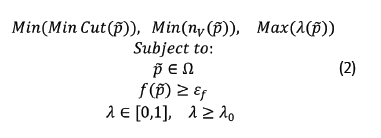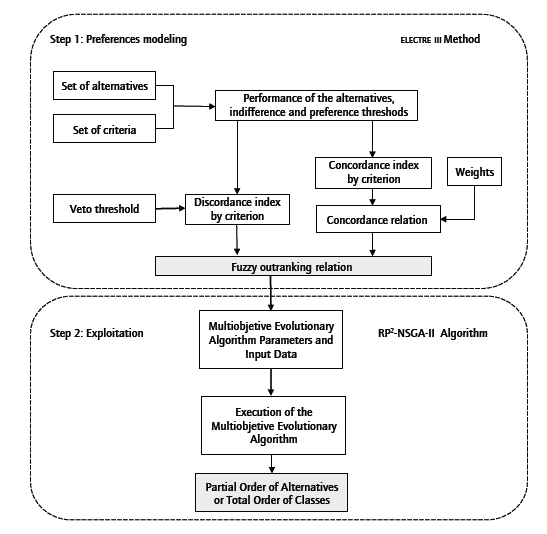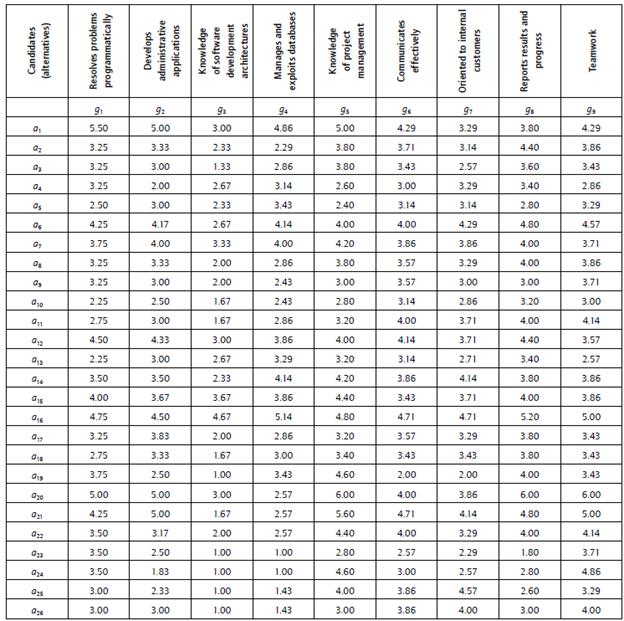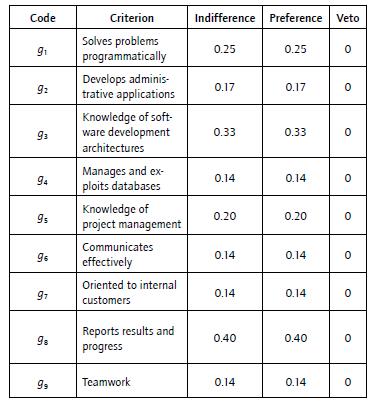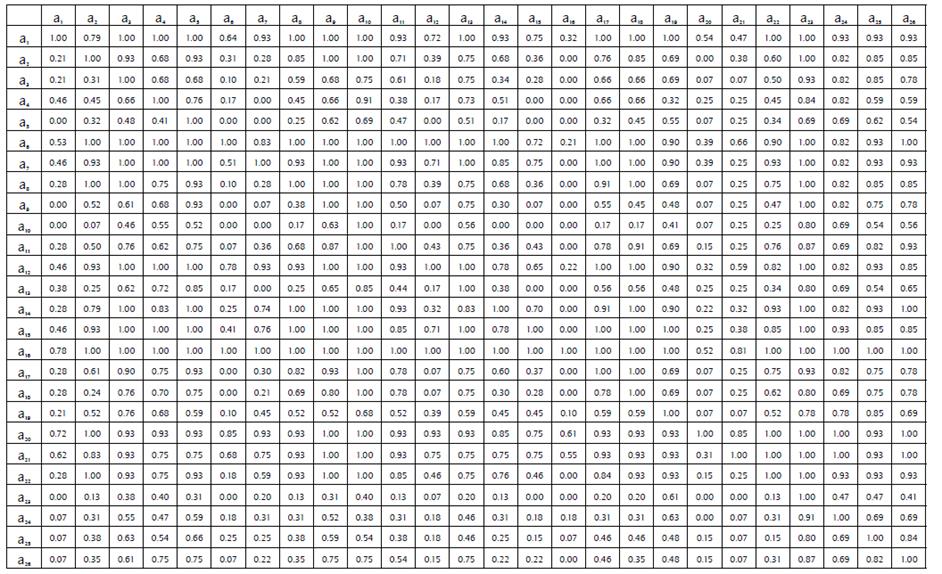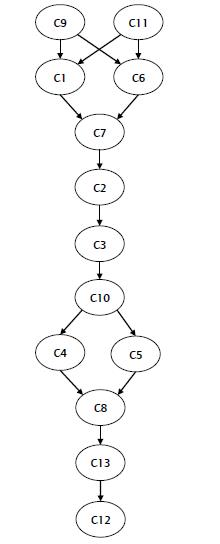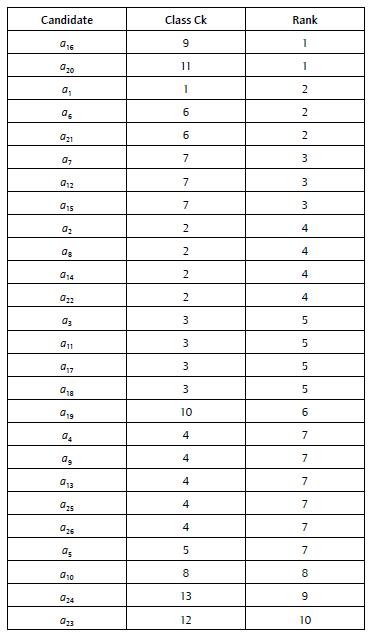Introduction
Personnel selection is a significant decision-making problem for organizations since the effectiveness of choosing the right people for specific tasks improves business performance. This activity can be defined as the process of selecting one or some persons from a set of candidates, considering that the selected individual has the qualities required to perform the assigned work in the best possible way (Zhang & Liu, 2011). In general, personnel selection is to find the appropriate point between a set of specified requirements for the vacant position and the applicants' skills. This problem has been processed in literature through conventional management techniques (Robertson & Smith, 2001) using application forms, initial interviews, employment examinations, and background investigations, among others.
One of the problems of conventional methods for personnel selection is that some of them depend on subjective judgments and exclude derived evaluations from objective analyses. For example, there is continuous feedback between the interviewer and their counterpart during an interview, where judgments of the assessment by the interviewer are modified based on the applicants' characteristics, interviewer's perceptions, and the interviewing process itself (Eder & Buckley, 1988). Likewise, conventional techniques are predominantly based on statistical analysis, where the solutions are handled as a precise replication of reality.
Using less conventional techniques requiring additional parameters or groups of evaluators (stakeholders) is considered an alternative to combining subjective and objective assessments of candidates in the personnel selection problem. In this sense, Afshari et al. (2010) believe that personnel selection is a complex problem because it operates in function of specific organizational objectives, the availability of resources, and the individual preferences of decision-makers.
Face this problem: a decision-maker should consider a finite set of available applicants. Given this scenario, it is feasible to use the Multicriteria Decision-Making (MCDM) approach to address the personnel selection problem. MCDM considers decision-makers' preferences on the criteria established to evaluate the set of alternatives. Usually, there is no single criterion that captures the performance of each applicant. Besides, through MCDM is possible to reduce the methodological bias, thus obtaining greater accuracy than traditional management methods and a proper way to model the subjectivity of personnel selection processes.
MCDM is an operational research approach that deals with complex decision-making problems with a set of decision alternatives assessed by a coherent family of criteria, where some of these criteria may conflict with each other. MCDM seeks to offer guidelines for decision-makers to resolve multicriteria decision problems. These guidelines can be translated into prescriptions or recommendations regarding the decision that should be made (Figueira et al., 2013). MCDM methods include a wide range of somewhat distinct approaches and can be broadly classified into two categories: discrete MCDM, also known as discrete MADM (Multi-Attribute Decision Making), and continuous Multi-Attribute Decision Making (Multi-Objective Decision Making) methods (Zavadskas & Turskis, 2011). This paper deals with the first type.
MCDM methods have been extensively applied in many real-world multicriteria decision problems in agriculture, environmental management, water management, finance, education, project selection, personnel employing and transportation, and services (Chang, 2014; Govindan & Jepsen, 2016). Recently, multicriteria-based methods have been used to evaluate candidates for a position (Gastelum-Chavira et al., 2017). However, such applications are still limited in quantity and scope. This relatively small number of applications is unusual considering that multicriteria methods can be adapted to economic and social sciences. Hence, this study applies a multicriteria-ranking-based approach in order to assess a set of contenders for a software developer job position in a real business in northwestern Mexico.
With the above in mind, this paper proposes applying an MCDM method to evaluate a set of candidates for a specific position in an organization, that is, to group and rank them considering particular competencies and skills required to perform a defined work in the best possible way.
It is known that human intervention in decision processes intrinsically includes a certain degree of subjectivity; the very evaluation of each candidate with the set of criteria provides subjectivity. The proposed method does not eliminate this subjectivity. However, it includes modeling vagueness as a type of uncertainty through the indifference and preference thresholds. For example, when comparing two candidates in each of the criteria, the decision-maker may consider candidates indifferent in some criteria if the difference between their values does not exceed a specific limit or threshold. These thresholds, however, are also defined subjectively, but allow the comparison to be made more flexible instead of narrowly limiting it. On the other hand, the proposed method tries to minimize inconsistencies related to the integral model of the decision maker's preferences when generating the ranking of candidates.
The remainder of this paper is organized as follows. The section after this introduction contains a description of the personnel selection problem and a literature review from the perspective of MCDM. The section after that includes a summarized version of the ELECTRE HI method. In this section we also describe the multi-objective evolutionary algorithm embedded in the software SADCACE in order to exploit the outranking relation. The analysis of the method in a real multicriteria problem of personnel selection is shown in the subsequent section. Then, we will introduce the results and the discussion around our findings. The last section presents some conclusions and future research lines.
Previous works
Organizations, in their human resources processes, have widely addressed personnel selection problems using MCDM methods and models as tools that assist in finding the best possible candidate (or set of candidates) that fulfills the requirements for a position. A large body of research proposes new applications of MCDM and hybrid methods to better solve these problems. Additionally, the existing literature shows the importance of research in this field and the need to explore more models and methodologies to develop more adequate selection processes for choosing the best candidate.
This section examines recent works on the field published during the 2015-2019 period. Such works present a variety of MCDM methods, such as Analytic Hierarchy Process (AHP) (Saaty, 1980), Technique for Order of Preference by Similarity to Ideal Solution (TOPSIS) (Hwang & Yoon, 1981), Preference Ranking Organization METHod for Enrichment of Evaluations (PROMETHEE) (Mareschal et al., 1984), Elimination Et Choix Traduisant la REalite (ELECTRE) (Roy, 1990), Analytic Network Process (ANP), VlseKriterijumska Opti-mizacija I Kompromisno Resenje (VIKOR), Stepwise Weight Assessment Ratio Analysis (SWARA), Multi-multi-objective Optimization on the Basis of Ratio Analysis (MULTIMOORA), Interactive and Multi-criteria Decision-Making (TODIM), Additive Ratio Assessment (ARAS-C), Simple Additive Weighting (SAW), Evaluation Based on Distance from Average Solution (EDAS), Eighted Average (OWA), Combinative Distance-Based Assessment (CODAS), and the Decision Making Trial and Evaluation Laboratory (DEMATEL).
As examples, Kusumawardani and Agintiara (2015) used AHP with TOPSIS for the manager selection problem in a telecommunications company. Sang et al. (2015) presented some experiments to analyze the impact of using fuzzy TOPSIS in the personnel selection application at a software company. Besides, Liu et al. (2015) introduced a 2-tuple linguistic VIKOR method and its application to a nurse recruitment problem in a tertiary care hospital as a group decision approach. Moreover, Alguliyev et al. (2015) proposed a fuzzy VIKOR method to solve a real decision-making problem aimed at ranking a set of candidates for the selection of the best option to fill a position at an innovation technology center. For their part, Karabasevic et al. (2015) introduced a hybrid MCDM method based on SWARA and MULTIMOORA methods to select the best candidate for an engineering position in the mining industry.
In the same line, Bilgehan-Erdem (2016) proposed fuzzy AHP as an approach for personnel selection problems in IT companies, presenting a case study for the selection of a developer for a university development department. Yu et al. (2017) extended the TODIM method for multicriteria group decision making (MCCDM) problems with unbalanced HFLTSS, illustrating its applicability in the selection problem of a sales manager for a company in the manufacturing industry. In the work by Urosevic et al. (2017), the SWARA and grey ARAS-C methods are proposed to resolve the personnel selection problem within the tourism industry, offering a hypothetical example to evaluate and select a sales manager. Stanujkic et al. (2017) tackled a problematic choice by integrating the Adapted Weighted Sum and SWARA methods in a personnel selection case study of three promoters for a marketing company.
Dahooie et al. (2018) introduced a multicriteria framework for IT personnel selection based on five competency class attributes. This framework is based on the ARAS-C method to weight the expert evaluation of criteria and the SWARA method to rank the candidates. Samanlioglu et al. (2018) presented an integrated approach based on the fuzzy AHP and TOPSIS methods to select the best candidate for an IT position at a dairy company. Dung et al. (2018) used TOPSIS along with an interval neutrosophic set for academic staff selection at a finance academy. Besides, Ji et al. (2018) presented an improved version of the TODIM method that overcomes some flaws of the original text, showing its usefulness at solving the problem of evaluating and selecting a sales supervisor for a manufacturing business. Widianta et al. (2018) made a comparison of AHP, SAW, TOPSIS and PRO-METHEE methods to explore how well each of these performs at solving the problem of evaluating employees and place them in the position where, according to their qualifications, they could play their best. These authors show that TOPSIS and PROMETHEE grant more accurate results according to some rankings previously made by recruitment experts. On another account, Karabasevic et al. (2018) presented an empirical application of the EDAS method to create a rank of systems support professionals with the purpose of selecting the two best candidates for a position in an IT business, while Wen et al. (2018) studied the use of the OWA operator and IPA as a model for the personnel selection problem, illustrating its potential for selecting the best students for admission at a university.
Added to the previous works, Jasemi and Ahmadi (2018) introduced a fuzzy ELECTRE approach to solving a personnel selection problem by incorporating linguistic values in each alternative's performances and criteria weights. Their work illustrates the use of the proposed approach to select an industrial engineer for a pipe manufacturing plant. Furthermore, Yeni and Ozcelik (2019) studied the use of the CODAS method with interval-valued Atanassov intuitionistic fuzzy sets, showing its applicability at an engineering company. Krishankumar et al. (2019) proposed a framework that combines interval-valued and intuitionistic fuzzy sets on the VIKOR method, presenting an empirical study for the selection of the best candidate for a programmer position at a software company. Nabeeh et al. (2019) integrated a neutrosophic AHP approach with TOPSIS through a case study for evaluating and selecting a set of candidates to fulfill a manager position in an Egyptian technology park. Demirci and Kilic's (2019) work presents a methodology for personnel selection that uses DEMATEL, ANP and ELECTRE in order to define the criteria to be evaluated among candidates, establish criteria weights, and rank candidates, respectively. An example of this methodology is presented in the selection process of an engineer for a rubber parts manufacturing company.
This literature review shows how MCDA methods have been used to solve personnel selection issues from 2015 to 2019, reflecting the importance of research within this field. Personnel selection is an active research area focused on exploring models and methodologies based on MCDA to help decision-makers (DMS) arrive at a more accurate selection of the best candidate to fulfill certain position. We can note that most of these papers focus on modeling personnel selection as an MCDA problem for solving recruitment problems with different specific characteristics within some business context through a case study, some of them using a single MCDA method. At the same time, few of them mix two or three MCDA methods. Only one paper was aimed at comparing the quality of the solutions resulting from the application of some MCDA methods. However, this experiment was based on experts' evaluations on a specific case, leaving results to the subjectivity of their evaluations.
From our perspective, there is not a best or worst MCDA method for personnel selection. The issue depends on the characteristics of a specific selection problem or the procedures organizations follow within their recruitment processes. Hence, recruiters must select the appropriate method based on their requirements. This is not only true when using MCDA methods for personnel selection, but to any other research field adopting MCDA methods for resolving a multicriteria problem. This is a problem on its own. Luckily, different approaches can be found in the literature (Bandyopadhyay, 2021; Guitouni & Martel, 1998; Olson et al, 1999).
The selection and evaluation to find the best method must be carried out by modeling a personnel selection problem as an MCDA problem, evaluating different approaches to determine which of these grants relevant results and better adjusts to the business context and the evaluation process. However, there is still room for improvement and to explore more techniques, so DMS could count on validated tools that can be used in specific situations.
The ELECTRE in method and the MOEA
The ELECTRE III method is an outranking method created by Bernard Roy (1990) to integrate the imprecision in the preference modeling of the decision-maker by using preference and indifference thresholds. This multicriteria method is based on the concordance and discordance principles. Besides, ELECTRE III is a non-compensatory method, which means that against an excellent performance on some evaluation criteria in an alternative, ELECTRE III does not compensate for the poor performance of other criteria for the same option.
The ELECTRE in method
ELECTRE III is a method that performs pairwise comparisons of the existing alternatives to deduce valued preference degrees between pairs of alternatives (Roy, 1990). A comprehensive literature review on the methodologies and applications on ELECTRE can be found in Govindan and Jepsen (2016). In this section, we will briefly show the method.
Let A=(a 1 , a 2 ,...,a m } be the set of alternatives and assume that there are distinct criteria g k , k = 1,2,...,r. For each pair of alternatives (a i ,a j )ЄAxA, there is a concordance measure C(a i ,,a j ) and a discordance measure d k (a i ,a j ). In the concordance index, we have, in a manner of speaking, a measure of the extent to which we are in harmony with the assertion that a, is at least as good as a,, while in the discordance index we allow the discordance related to this statement. The model building stage gathers these two measures to produce a credibility index σ(a i ,a j ) (0 ≤ σ (a i ,a j ) ≤ 1), which calculates the strength of the statement “a_i is at least as good as a i , a i Sa j .” The credibility degree for each pair (a i ,a j ) ∈ A×A is quantified as follows:
In (1), K(a i ,a j ) denotes a set of criteria such that dk (a i ,a j )>C(a i ,a j ), and considers that if the strength of the concordance surpasses that of the discordance, then the concordance value should not be adjusted. If not, we are forced to examine the affirmation that a i Sa j , and adjust C(a i ,a j ) according to equation (1). If the discordance index takes the value of 1 for any (a i ,a j )∈A×A and any criterion k, then we have no confidence that a i Sa j . Consequently, σ(a i ,a j )=0. Therefore, we have built a valued outranking relation on SAσ on A×A. In this relation, we link with each pair (a i ,a j )∈A×A a number σ(a i ,a j )(0≤σ(a i ,a j )≤1), indicating the degree of strength of the reasons that favors the crisp outranking ai Saj.
The valued outranking relation S A σ is exploited through a multi-objective evolutionary algorithm-based heuristic method. This model is explained in the section “The multi-objective problem and the moea.”
Configuration of the decision aiding process
The decision process concept has been linked to organizational studies to examine how organizations face decision situations. According to Tsoukiás (2008), the "decision aiding process" is a kind of "decision process" whose main objective is to achieve a consensus between the decisionmaker and the analyst. On the one hand, the decision-maker has domain knowledge about the decision process, while the analyst has methodological expertise on how to address the problem. Generally, the process of decision support can be summarized as follows: given the domain knowledge of the decision-maker and the methodological expertise of the analyst, the latter interprets the interests and expertise of the first to improve the point of view of the decision-maker regarding a particular decision process. This interpretation must be "consensual," i.e., the decision-maker must consider their understanding about the situation, while the analyst must consider it as proper and meaningful.
A decision aiding process involves a set of activities in the interaction between the decision-maker and the analyst. This process could be perceived linearly, but it is not really so in practice. At any stage of the process, the decision-maker can return to a previous stage to make changes with the help of the analyst. Thus, it is about an iterative process with feedback, which gradually builds a problem solution.
The multi-objective problem and the MOEA
From an optimization perspective, there are two kinds of problems: mono-objective and multi-objective. The first type can be modeled through an objective function to be optimized and subject to several constraints. In such situations, one solution is obtained (if any). On the other hand, multi-objective problems are modeled by a group of objective functions to be simultaneously optimized, since the restrictions defined herein are met. In multi-objective problems, generally, there is no single solution but a set of Pareto optimal solutions. Thus, finding the best compromise between its objective functions is necessary. As example, for a multicriteria ranking problem, each potential solution ranks the set of alternatives (candidates in our personnel selection problem). For exploiting a valued outranking relation SA and deriving a ranking of alternatives that best fit the preferences of the decision-maker, represented by S σ A we formulate it as a multi-objective optimization problem, where three objective functions are identified. These functions are defined as follows.
Objective functions
Maximum Cut Level objective
each potential solution
 in the space Ω of potential solutions is linked with a λ - cut, which means a credibility level of a crisp outranking relation S
λ
A
defined on AxA. We are looking for potential solutions with a credibility level λ close to 1, which reveals that the deduced ranking from the decoded potential solution is more convincing. This objective is referred to as the Maximum Cut Level objective.
in the space Ω of potential solutions is linked with a λ - cut, which means a credibility level of a crisp outranking relation S
λ
A
defined on AxA. We are looking for potential solutions with a credibility level λ close to 1, which reveals that the deduced ranking from the decoded potential solution is more convincing. This objective is referred to as the Maximum Cut Level objective.
The modeling of the multi-objective problem uses an extra constraint for the credibility level λ. This is a f function that does not allow λ values to be close to one, since under those circumstances the number of incomparabilities between alternatives increases. The quality of a solution increases while the value of f decreases. In this case, we are interested in those individuals whose f "values are equal to or near zero. This condition improves the comparability of the credibility index S on A.
The MinCut objective
This objective performs the necessary work so that the alternatives in each class are, as far as possible, indifferent to each other. Operatively, the MinCut maximizes the number of indifferences into the classes and penalizes the pairs of alternatives that are not indifferent. This objective function is minimized in this optimization problem, called MinCut objective.
The Minimum Pair-wise Disagreement objective
The quality of the final crisp outranking relation S pk(A) should be judged counting the number of discrepancies and concordances between the fuzzy outranking relation Sσ A, which represents the decision-maker preferences, whereas the crisp outranking relation Sλ A. P K (A) represents a partition of the set A. For that reason, a n V function to count the number of preferential pairwise disagreements is defined. This function computes the total of preference relations between pairs of alternatives in Sλ A, which disagree with S* pk(A) This is called the Minimum Pair-wise Disagreement objective.
The multi-objective optimization problem
Based on the defined objectives, the multi-objective optimization problem that a multi-objective evolutionary algorithm (MOEA) tries to solve is:
where
Ω is the set of antisymmetric crisp outranking relations of classes of alternatives of A.
 is an antisymmetric crisp outranking relation of classes of A.
is an antisymmetric crisp outranking relation of classes of A.
f(
 ) is the number of incomparabilities between pairs of alternatives (a, b) in the individual
) is the number of incomparabilities between pairs of alternatives (a, b) in the individual
 , in the sense of the relation Sλ
A.
, in the sense of the relation Sλ
A.
ε f is an objective value.
λ 0 is a minimum credibility level.
Usually, this optimization task does not have the best solution. Instead, a set of solutions that form an optimality Pareto front is obtained.
The multi-objective evolutionary algorithm
The existence of many real-life problems that require different objectives to be simultaneously optimized have resulted in the development of some techniques to address these kinds of problems, such as multi-objective evolutionary algorithms (MOEA). The multi-objective optimization based on evolutionary processes is a suitable tool for treating this type of problems, since these processes are characterized to explore the objective space of the problem and get a set of solutions with the best compromise between the optimized objectives.
The MOEA applied in this work is known as RP 2-NSCA-II (Leyva-López et al., 2021), which is embedded in SADCACE software (Leyva-López et al., 2016). RP 2-NSCA-II exploits a fuzzy outranking relation to build a recommendation for the multicriteria ranking problem of a medium-sized set of alternatives. Specifically, this algorithm generates a partial order of classes of alternatives.
RP 2-NSCA-II overview
RP2-NSCA-II is based on the NSCA-II algorithm (Deb et al., 2002). The individual representation of the RP2-NSCA-II is a matrix representation of a crisp outranking relation, which is decoded as a partial order of classes of alternatives. The population initialization process is based on Handl and Knowles (2005), who used two procedures: Prim algorithm (Prim, 1957) and an extension of k-means (De-Smet & Montano-Guzmán, 2004). The selection method uses the Tournament Selection Method and the crossover operator implemented in the RP 2-NSCA-II is the Uniform Crossover Operator (Syswerda, 1989). RP 2-NSCA-II uses a modified version of the Uniform Mutation concerning the mutation operator. This operator requires just one parent to produce a single offspring. The decoding procedure to determine the ranking of classes of alternatives includes the Bread-First search algorithm. Such procedure generates a Hasse diagram of classes as output. Figure 1 shows a crisp outranking relation of classes S* PK(A) , where A is the set of alternatives and the Hasse diagram produced by the procedure to obtain a ranking.
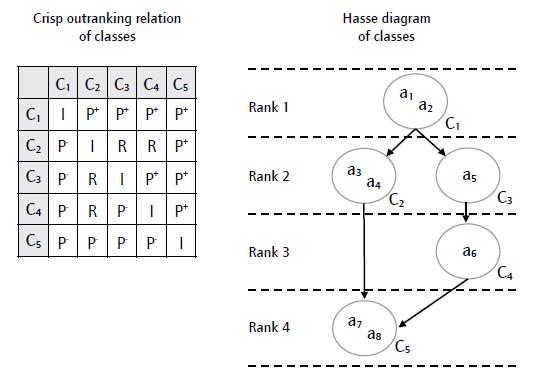
Source: authors. Note: In the Crisp outranking relation of classes, I,P+,P,R denote, respectively, the indifference, preference, not preference, and incomparability relations between alternatives.
Figure 1 Crisp outranking relation of classes and its Hasse diagram.
In figure 1, class C, is assigned to the first rank, and it is preferred to C2, this is C, PC 2 . In the Hasse diagram, an arrow from C, to C 2 is drawn due to the coverage relation, and there is not a class q G S* PK ( A ) such that C, P + C q A C q P + C 2 . On the other hand, C, P+C 4 is not a coverage relation because C, P+C 3 A C 3 P+C 4 . Therefore, there is not an arrow between C, and C 2 . C, P+C 4 is deduced in the Hasse diagram by the transitivity property.
RP 2-NSGA-n is based on reducing the differences between the valued outranking relation SI and the final ranking. More information on this algorithm is provided in the work by Leyva-López et al. (2021). The general outline of the ELECTRE-III-RP 2-NSGA-II method is presented in figure 2.
An empirical application
This study evaluates a set of applicants for a position as software developer at an enterprise located in the northwest of Mexico. The studied enterprise develops web-based and mobile device software. That company had a personnel recruitment activity for a software developer position, for which 26 candidates competed. Applicants were assessed based on nine explicit skills interconnected to developing computer programs, communication, and teamwork.
A software developer is in charge of developing computer systems and implementing them. Software developers write source codes that are then translated into a functional website or application. Depending on the area of specialization, a software developer can create application programs for desktop systems (standalone), web-based systems, mobile phones and tablets, or embedded software used in microwaves, cars, and televisions, among other devices, accessing (or not) local and remote databases. In addition to the technical skills and logical reasoning, a software developer may have to discuss requirements with clients and team members. Besides, this professional must present and review project progress, teamwork, and follow the guidelines set within project requirements, including diagrams modeling languages, among others.
As can be seen, the recruitment of this type of professional can be modeled as a multicriteria ranking problem, where the set of alternatives are the applicants and the criteria corresponds to the required skills for the software developer position.
Data source
This study used real data obtained from a database provided by the participating software development company. Particularly, data from the office located in Sinaloa, Mexico, were used. This information corresponds to the aggregate of competence and sub-competencies assessments of 26 candidates for the aforementioned position. The research team did not contribute to data generation.
Criteria
Evaluation criteria were designed to capture the multidimensional nature of the performance of the alternatives. When choosing a family of criteria for evaluating a set of alternatives, this should be sufficiently small (legible). Also, it should be operational and must contain all points of view (comprehensive), be monotonous, and each criterion should be counted only once (no redundancy). Upon completing these rules, it is said that a coherent family of criteria is defined (Bouyssou, 1990). For this research, the software company described the criteria to be considered (table 1). All the criteria were oriented to reach maximums and defined on a scale of 0 to 6, where:
6) Excellent: outstanding level competition.
5) Very good: competition level substantially higher than needed.
4) Good: top-level competition to the needed.
3) Satisfactory: corresponding level of competence needed.
2) Sufficient: minimum level of competence needed.
1) Insufficient: competition level below that needed.
0) Very poor: zero level competition.
Table 1 Criteria of the research study.
| Code | Name Description | |
|---|---|---|
| g 1 | Resolves problems programmatically | The developer can design and program algorithms to solve problems, using creativity and knowledge of the different tools, depending on the situation. |
| g 2 | Develops administrative applications | The developer has knowledge of software engineering and programming languages for desktop applications and web-based applications; likewise, he/she can capture in a program the requirements requested for the development of a system following coding standards. |
| g 3 | Knowledge of software development architectures | The developer knows the unified modeling language (UML) and architectural design patterns applied methodologies. |
| g 4 | Manages and exploits databases | The developer knows how to install a database server and manage a database through a Database Management System. Similarly, he/she knows the ways to normalize a database and dominates Data Manipulation Language (DML) and Data Definition Language (DDL). He/she knows how to use Stored Procedures (SP), Triggers, and Cursors. Finally, the developer should know about database migration to other platforms. |
| g 5 | Project management knowledge | The developer knows project definitions, and is familiar with the terms of the administration thereof. He/she can calculate the time required to perform a particular task, knows what a work breakdown structure is, and performs well at interpreting Gantt diagrams. |
| g 6 | Communicates effectively | The developer can address a request made by his/her supervisor and calmly dialogues upon differences of views. He/she meets the means to contact his/her teammates and the rest of the company. The wording of his/her work emails is precise and formal. The developer can communicate in Spanish effectively both verbally and in writing. He/she can speak in front of many people and is able to ask his/her supervisor for information and resources to carry out assignments in a timely manner. |
| g 7 | Oriented to internal customers | The developer knows who the client is and the kind of services required. He/she is proactive in communicating with clients and knows how to communicate with them. The developer fixes positions and respects agreements with clients and suggests improvements regarding agreed times. |
| g 8 | Reports results and progress | The developer knows to whom he/she must report progress and results effectively and regularly. He/she meets formats for progress and results. The developer makes impact presentations of results and fills his/her timesheet when a task is done. |
| g 9 | Teamwork | The developer respects his/her teammates views and respects his/her supervisor as an authority figure. Also, the developer participates actively in meetings, being proactive. He/she knows who his/her teammates are and communicates changes that could affect the rest of the team. The developer prevents turning labor disputes into personal situations. |
Source: authors.
This scale was chosen due to the complexity and uncertainty of real-world decision-making problems and the inherent subjectivity of human judgment; exact judgments are often unrealistic or infeasible. As a result, decision-makers often find it more natural or easier to assign linguistic variables to their assessments than making fixed value judgments.
It is possible to group the competencies of the candidates in thematic groups. However, by doing this, the identification of the competencies where the candidate has weaknesses is complicated, as well as recognizing those where they are strong, regardless of whether these are generic or professional competencies.
All applicants were assessed by the criteria in table 1. The assessment of all of them is presented in table 2, which is also known as the performance matrix. In table 2, we can see that no candidate (alternative) exceeds other applicants in any of the criteria examined, neither there is a candidate surpassed by another in all the criteria, i.e., table 2 is a set of non-dominated candidates.
Weights
The calculation of criteria weights was obtained through the Personal Construction Theory (Rogers et al, 2000), shown in table 3. In this stage, the decision-maker is asked about the importance of the criteria through pair-wise comparison. For each pair of criteria g and g the decision-maker is asked if the criterion g is more, equal, or less important than g r Subsequently, the number of times n that each criterion was more important than the rest is considered. If some criterion has not been more important than another, the quantity n of each criterion is added 1. Afterwards, summation s of the n obtained is carried out. Finally, the weight of each criterion is obtained by dividing n of each criterion by s and multiplying the result by 10. The weights obtained represent the relative importance of each criterion, where the higher the value received, the greater the importance. Table 3 shows the weights obtained.
Table 3 Criteria weights.
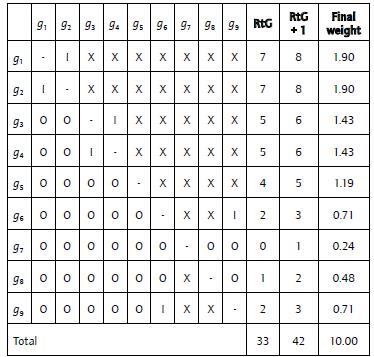
Notes: (i) RtG ← RtG+1 to take into count criterion 8; (ii) for each cell ij,{X,I,O} means that criterion gi is {greater, equal, less} important than criterion gj; (iii) the weight for each criterion gi is obtained by dividing RtG ← RtG+1 by the total and later multiplied by 10.
Source: authors.
Thresholds
The thresholds used in this study were specified by an executive of the participating company, who acted as the decision-maker, and the authors of this work, as the analyst. Table 4 presents the indifference and preference thresholds of the criteria used. The veto threshold was defined only in the first two criteria, considering it is the most important.
Preferential model
Several factors influenced the specific selection of the ELECTRE III-MOEA methodology for the problem of personnel selection. First, we present an MOEA to derive a ranking from a valued outranking relation by validating the functionality of the ELECTRE III-MOEA approach in a real-world problem. Secondly, a set of candidates and a set of human resources characteristics can be transformed into a set of alternatives and a set of criteria, respectively. Moreover, the problem can be modeled as a multicriteria ranking problem. As a third point, the ELECTRE III method was initially developed by Roy (1990) to consider the imprecise and uncertain nature of decision-making by using thresholds of indifference and preference. We also used the fact that ELECTRE III is a non-compensatory method. Another characteristic is that ELECTRE models allow incomparability. Finally, but not least, the selection of ELECTRE III was also influenced by other successful applications of this method (see Govindan & Jepsen [2016] for a list of successful applications of ELECTRE).
By considering the performance of candidates (table 2), the relative importance of the criteria (table 3), and the indifference, preference and veto thresholds (table 4), we constructed a valued outranking relation through the ELECTRE III method. Table 5 shows the valued outranking relation as a credibility matrix.
MOEA configuration
The MOEA was applied with the following parameters: the number of generations of the population was set at 2,000, the population size at 40, and the crossover probability at 1.00. The probability mutation is dynamic and was not considered as a required parameter. The minimum cut level λ min and the maximum cut level λ max, required to exploit the valued outranking relation, were set at 0.60 and 0.77, respectively.
Results and discussion
From exploiting the valued outranking relation with RP 2-NSGA-II, we obtained the ranking depicted in figure 3, which corresponds to a partial order of candidates (alternatives) with 13 classes in descending order of preference (i.e., classes at the top are preferred over the classes below).
Table 6 describes each candidate's class and their relative position in the ranking. It should be noted that this ranking suggests some classes are incomparable to each other (e.g., classes 9 and 11, 1 and 6, 4 and 5). Class 9 and 11 are in the first position (rank 1) of the ranking. Class 9 is composed by candidate 16, while class 11 by candidate 20, which means that these are the preferred applicants. In rank 2 we find class 1 (candidate 1) and class 6 (candidates 6 and 21); rank three includes class 7 (candidates 7, 12, and 15); rank four contains class 2 (candidates 2, 8, 14, and 22); rank five includes class 3 (candidates 3, 11, 17, and 18); rank six has class 10 (candidate 19); rank 7 gathers classes 4 (candidates 4, 9, 13, 25, and 26) and 5 (candidate 5); rank eight contains class 8 (candidate 10); rank nine has class 13 (candidate 24); and rank ten includes class 12 (candidate 23).
Table 6 shows the ranking of candidates and the class they belong to. Figure 3 depicts the partial preorder of candidates' classes representing the final ranking generated by RP 2-NSCA-II. As shown in figure 3, RP 2-NSCA-II obtained 13 classes with 32 inconsistencies (10 inside the classes and 22 between classes). In total, the ranking had a 9.84% of inconsistencies concerning the valued outranking relation, which is considered an acceptable inconsistency threshold.
This ranking suggests that the best candidates are applicants 16 and 20. These two candidates are in the first position but are incomparable. However, they are equally preferred to the DM. There is no way to decide which one is better since each candidate is superior at different criteria. It should be noted that incomparable is different than indifference: if candidates were indifferent they would perform quite similarly in all criteria. Therefore, no distinction could be made. We can prove this with their performance scores in table 2. Candidate 20 outperforms candidate 16 in criteria g 2¡ g5 g 8 and g9, while candidate 16 outperforms candidate 20 in g3i g4 g6 and g7. It is important to mention that candidate 20 has the highest possible value in criteria g5i g8 and g9, which have lower importance (weight) in the evaluation model. This insight gives the DM new perspectives for a better selection as this reflects a fair evaluation of candidates, according to the DM'S preferences. This is one of the greatest features of the outranking models, since other models would create a total preorder, or even a total order, of candidates that would hide this relevant insight.
Conclusions and future research
This paper sought to offer a different way for personnel selection at an organization by using a Multicriteria Decision Aiding Approach. The suggested process for rank-order candidates adopts the ELECTRE III method to build a valued outranking relation and then use a multi-objective evolutionary algorithm based on NSCA II to get a ranking of the candidates in decreasing order of preferences. This method was applied using data from a real case in a software development company in northwestern Mexico.
The employed multicriteria methodology for personnel selection is both realistic and suitable. Besides, the recommended multicriteria assessment structure offers a rationale for involved stakeholders at public and private organizations.
The proposed methodology is flexible and adequately represents the imprecision and uncertainty intrinsic to any modern organization. This approach could help human resources managers reach better decisions by selecting employees after making a complete analysis of the organization's objectives and candidates' competencies. Additionally, this methodology can be applied to improve the value of current employees. For instance, weaknesses can be identified and then properly addressed by providing comprehensive training, continuous learning and development activities to new staff.
Finally, ELECTRE III may be employed to address several human resource issues other than the selection process. Typical applications include the evaluation of training and development programs and the assessment of individual employees or workgroups. The case reported in this paper highlights the appropriateness of multi-objective evolutionary algorithms to real-world management problems in a multi-criteria decisional situation. Consequently, this research study also adds to an increasing corpus of application-based knowledge that was, until very recent times, a restricted territory of engineering and natural sciences.
In the future, in order to highlight the efficiency of this method, we will intend to use an empirical approach to test our methodology on a set of benchmarks with a wide variety in their structure. Validation tests will be conducted on both artificial and real data sets. It will also be essential to explore the limits of this approach by finding the top size within instances that can be solved with an acceptable performance.















